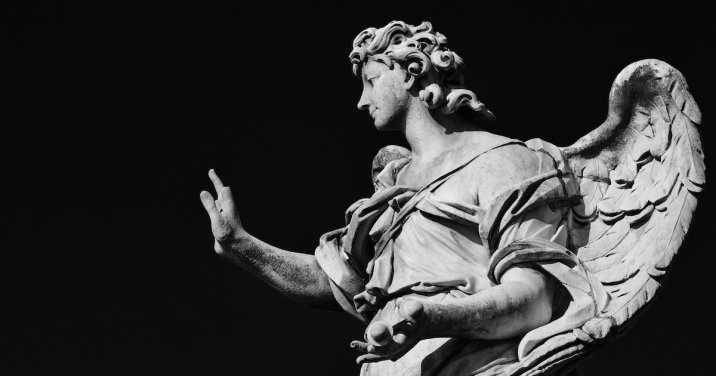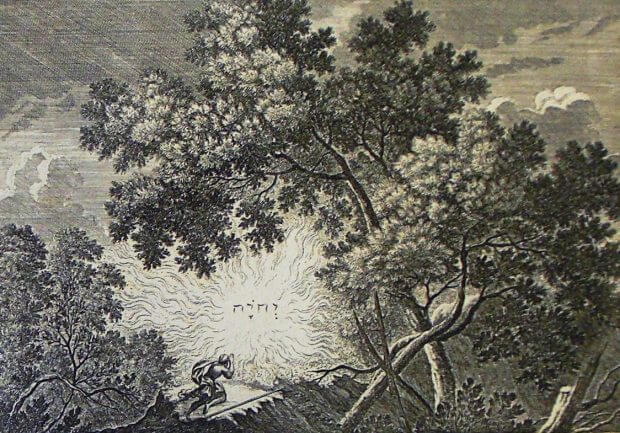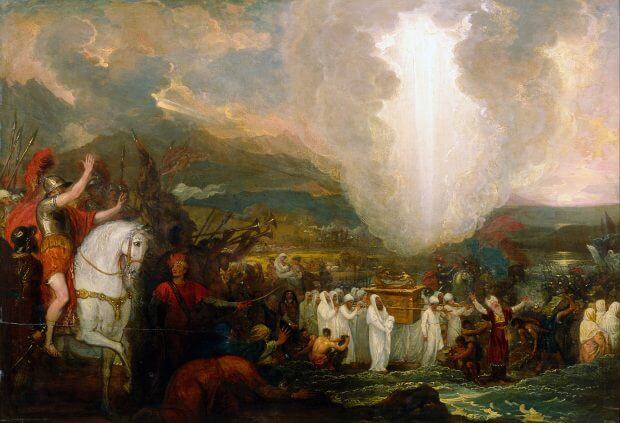In Exodus 3, God famously appears to Moses in a burning bush and sends him to rescue the Israelites. Fearing nobody will believe him, Moses says, “Suppose I go to the Israelites and say to them, ‘The God of your fathers has sent me to you,’ and they ask me, ‘What is his name?’ Then what shall I tell them?” (Exodus 3:13).
And then God tells us his name.
“I am who I am. This is what you are to say to the Israelites: ‘I am has sent me to you’” (Exodus 3:14).
I am—or in Hebrew, YHWH (Yahweh). Most people have at least heard of the story of the burning bush before, and you’ve probably heard that Yahweh is one of the ways the Bible refers to God.
But the name of Yahweh isn’t just a personal pronoun. In Scripture, the phrase “the Name” actually signifies the presence of Yahweh. “The Name” is personified, and it’s used interchangeably with Yahweh himself. It even blurs the lines between two separate beings: Yahweh and the angel of the Lord.<!-more–>
“The name of Yahweh” as it’s used in the Old Testament plays an important role in Christian theology: it lays the foundation for the Trinity, and God’s incarnation as man in Jesus Christ.
In his groundbreaking book, The Unseen Realm: Recovering the Supernatural Worldview of the Bible, Dr. Michael S. Heiser uses his expertise in Semitic languages and the Hebrew Bible to piece together what we know about “the name of Yahweh,” honing in on the ambiguous relationship between Yahweh and the angel of the Lord, who often appears when Yahweh is speaking.
The following post is adapted from The Unseen Realm.
Yahweh was in the burning bush
Moses’ encounter with God at the burning bush has been etched into our minds by Sunday school teachers, ministers, and of course Cecil B. DeMille’s epic film The Ten Commandments. But there’s something you may have never noticed about the bush. Hollywood certainly missed it.
“And Moses was a shepherd with the flock of Jethro, his father-in-law, the priest of Midian, and he led the flock to the west of the desert, and he came to the mountain of God, to Horeb. And the angel of Yahweh appeared to him in a flame of fire from the midst of a bush, and he looked, and there was the bush burning with fire, but the bush was not being consumed.
And Moses said, ‘Let me turn aside and see this great sight. Why does the bush not burn up?’ And Yahweh saw that he turned aside to see, and God called to him from the midst of the bush, and he said, ‘Moses, Moses.’ And he said, ‘Here I am.’ And he said, ‘You must not come near to here. Take off your sandals from on your feet, because the place on which you are standing, it is holy ground.’ And he said, ‘I am the God of your father, the God of Abraham, the God of Isaac, and the God of Jacob.’ And Moses hid his face because he was afraid of looking at God.” —Exodus 3:1–6
The text quite clearly states that “the angel of Yahweh” was in the bush (v. 2). But when Moses turns to look at the bush (v. 3), the text has Yahweh observing him and calling to him—“from the midst of the bush” (v. 4). Both the Angel—the visible Yahweh in human form—and the invisible Yahweh are characters in the burning bush scene.
Interestingly, verse 6 tells us that Moses was afraid to look at God. This suggests that he had discerned something other than fire in the bush—most likely, the human form of the angel. The New Testament affirms this description in Acts 7:30–35. The martyr Stephen twice tells us that there was an angel in the bush (verses 30, 35).
Is the angel of Yahweh actually Yahweh?
In the conversation that ensues, Yahweh (v. 7) reveals his covenant name to Moses: I AM (Exod 3:14). If Yahweh is speaking to Moses, one has to wonder why the Angel was needed. If Yahweh is doing the talking, why does he need a messenger? Or perhaps when the writer says Yahweh is speaking, he means the Angel.
Like passages in Genesis (such as Genesis 20:10-18), Exodus 3 includes Yahweh and his angel in the same scene as distinct figures, but then creates ambiguity between them. Are there two or one? Are the two the same but different? The reader is being prepped for something dramatic to come. We won’t have long to wait.
The name of Yahweh is in the angel
We know what happens after the burning bush. Yahweh, through Moses, delivers Israel from Egypt. Moses leads the people to Sinai to meet their God, receive the law, and prepare for the journey to the promised land. There’s a short conversation between God and Moses about that task that is habitually overlooked by Bible readers. In Exodus 23 God says:
“‘Look, I am about to send an angel before you to guard you on the way and to bring you to the place that I have prepared. Be attentive to him and listen to his voice; do not rebel against him, because he will not forgive your transgression, for my name is in him. But if you listen attentively to his voice and do all that I say, I will be an enemy to your enemies and a foe to your foes.” —Exodus 23:20–22
“The name” of Yahweh is Yahweh
There’s something strange about God’s description to Moses that tells us that this is no ordinary angel. This angel has the authority to pardon sins or not, a status that belongs to God. More specifically, God tells Moses that the reason this angel has this authority is “my name is in him” (Exodus 23:21).
What does this curious phrase mean? Moses knew instantly. Anyone thinking of the burning bush account does as well.
When God told Moses that his name was in this angel, he was saying that he was in this angel—his very presence or essence. The I AM of the burning bush would accompany Moses and the Israelites to the promised land and fight for them. Only he could defeat the gods of the nations and the descendants of the Nephilim whom Moses and Joshua would find there.
The Old Testament uses Yahweh and his angel interchangeably
Other passages confirm that this reading is correct. This angel is Yahweh. Perhaps the easiest way to demonstrate this is to compare Old Testament passages about who it was that brought Israel out of Egypt and into the promised land.
“I am Yahweh, who brought you up from the land of Egypt to be for you as God.” —Leviticus 11:45
“You yourselves were shown this wonder in order for you to acknowledge that Yahweh is the God; there is no other God besides him. From heaven he made you hear his voice to teach you, and on the earth he showed you his great fire, and you heard his words from the midst of the fire. And because he loved your ancestors he chose their descendants after them. And he brought you forth from Egypt with his own presence, by his great strength, to drive out nations greater and more numerous than you from before you, to bring you and to give to you their land as an inheritance, as it is this day.” —Deuteronomy 4:35–38
“Yahweh our God brought us and our ancestors from the land of Egypt, from the house of slavery, and did these great signs before our eyes. He protected us along the entire way that we went, and among all the peoples through whose midst we passed. And Yahweh drove out all the people before us.” —Joshua 24:17–18a
“And the angel of Yahweh went up from Gilgal to Bokim and said, ‘I brought you up from Egypt, and I brought you to the land that I had promised to your ancestors.’” —Judges 2:1
These passages interchange Yahweh, the Angel of Yahweh, and the “presence” (panim) of God as the identity of the divine deliverer of Israel from Egypt. There weren’t three different deliverers. They are all the same. One of them, the angel, takes human form.
If Deuteronomy 4:37 is read in light of Exodus 23:20–23, then the presence and the Angel are co-identified. This makes good sense in view of the meaning of the “Name” which was in the Angel.
“The Name” of Yahweh is personified
Some readers with Jewish friends or a Jewish background know that even today the phrase “the Name” (ha-shem) is used by many Jews in the place of the divine name Yahweh. The biblical passages we’ve seen above show that there is biblical precedent for the practice.
In other passages, “the Name” functions as a substitute word for Yahweh. In several the Name is personified—the Name is a person. Isaiah 30:27–28 is quite striking in this regard:
“Look! The name of Yahweh comes from afar,
burning with his anger and heaviness of cloud.
His lips are full of indignation,
and his tongue is like a devouring fire.
And his breath is like an overflowing river;
it reaches up to the neck.”
The Name is clearly cast as an entity, as Yahweh himself, in this text. This is explicit in Psalm 20:
“May Yahweh answer you in the day of trouble.
May the name of Jacob’s God protect you.” —Psalm 20:1
“Some boast in chariots and others in horses,
but we boast in the name of Yahweh, our God.” —Psalm 20:7
How is it that the psalmist would pray that “the Name” protect anyone? Israelites wouldn’t get much protection from a string of consonants (Y-H-W-H). The point of the psalm is that trusting in the Name means trusting in Yahweh himself—he is the Name.
Deuteronomy has a lot to say about the Name, especially with respect to the Name being the very presence of God that will reside in the Tabernacle, the holy city, and eventually the Temple. Deuteronomy 12 is representative (note the emphasis in bold):
“You must completely demolish all of the places there where they served their gods, that is, the nations whom you are about to dispossess” —Deuteronomy 12:2
“You shall not worship Yahweh your God like this. 5 But only to the place that Yahweh your God will choose from all of your tribes to place his name there as his dwelling shall you seek, and there you shall go” —Deuteronomy 12:4–5
“and then at the place that Yahweh your God will choose, to let his name dwell there, there you shall bring all the things I am commanding you.” —Deuteronomy 12:11
The commander of Yahweh’s army
Readers may have already anticipated that the angel in whom Yahweh’s name, his presence, dwells can be identified as the mysterious figure encountered by Joshua just before the wars of conquest. I would agree. Here is the passage in Joshua 5:
“And it happened, when Joshua was by Jericho, he looked up, and he saw a man standing opposite him with his sword drawn in his hand. And Joshua went to him and said, ‘Are you with us, or with our adversaries?’ And he said, ‘Neither. I have come now as the commander of Yahweh’s army.’ And Joshua fell on his face to the earth, and he bowed down and said to him, ‘What is my lord commanding his servant?’ The commander of Yahweh’s army said to Joshua, ‘Take off your sandals from your feet, for the place where you are standing is holy.’ And Joshua did so.” —Joshua 5:13–15
An important clue to identifying this “man” as the angel of Yahweh is the drawn sword in his hand. The Hebrew phrase here occurs only two other times: Numbers 22:23 and 1 Chronicles 21:16. Both explicitly name the Angel of Yahweh as the one with “drawn sword” in hand.
The connection is unmistakable on two other counts. Joshua bows to the man, an instinctive reaction to the divine presence. The commander orders Joshua, “Take off your sandals from your feet, for the place where you are standing is holy.” The wording comes from Exodus 3:5, the burning bush passage. The angel of Yahweh was in that bush.
The angel of Yahweh departs from Israel
The angel of Exodus 23:20–23 did indeed go with Moses and Joshua to claim the promised land. In the wake of Joshua’s death, however, Israel failed to complete the task. The Angel of Yahweh appeared in Judges 2 bringing news no one wanted to hear:
“And the angel of Yahweh went up from Gilgal to Bokim and said, ‘I brought you up from Egypt, and I brought you to the land that I had promised to your ancestors. I said, “I will never break my covenant with you. And as for you, do not make a covenant with the inhabitants of this land; break down their altars.” But you did not listen to my voice. Why would you do such a thing? Now I say, I will not drive them out from before you; they will become as thorns for you, and their gods will be a trap for you.’ And as the angel of Yahweh spoke these words to all the Israelites, the people wept bitterly.” —Judges 2:1–4
The angel of Yahweh’s departure signaled an end to the regular presence of Yahweh with Israel. But even in the dark period of the judges he wouldn’t stay away completely.
Yahweh and his angel are one, and yet separate
The call of Gideon in Judges 6 includes one appearance during this period. The passage is lengthy, so the important items are in bold.
“The angel of Yahweh came and sat under the oak that was at Ophrah that belonged to Jehoash the Abiezrite; and Gideon his son was threshing wheat in the winepress to hide it from the Midianites. The angel of Yahweh appeared to him and said to him, ‘Yahweh is with you, you mighty warrior.’ Gideon said to him, ‘Excuse me, my lord. If Yahweh is with us, why then has all this happened to us? Where are all his wonderful deeds that our ancestors recounted to us, saying, “Did not Yahweh bring us up from Egypt?” But now Yahweh has forsaken us; he has given us into the palm of Midian.’ And Yahweh turned to him and said, ‘Go in this your strength, and you will deliver Israel from the palm of Midian. Did I not send you?’ He [Gideon] said to him, ‘Excuse me, my lord. How will I deliver Israel? Look, my clan is the weakest in Manasseh, and I am the youngest in my father’s house.’ And Yahweh said to him, ‘But I will be with you, and you will defeat Midian as if they are one man.’ And he said to him, ‘Please, if I have found favor in your eyes, show me a sign that you are speaking with me. Please, do not depart from here until I come back to you and bring out my gift and set it out before you.’ And he said, ‘I will stay until you return.’
“And Gideon went and prepared a young goat and unleavened cakes from an ephah of flour; he put meat in a basket, and the broth he put in a pot, and he brought them to him under the oak and presented them. The angel of God said to him, ‘Take the meat and the unleavened cakes and put them on this rock; pour the broth over it.’ And he did so. Then the angel of Yahweh reached out the tip of the staff that was in his hand, and he touched the meat and the unleavened cakes; and fire went up from the rock and consumed the meat and the unleavened cakes. And the angel of Yahweh went from his sight. And Gideon realized that he was the angel of Yahweh; and Gideon said, ‘Oh, my lord Yahweh! For now I have seen the angel of Yahweh face to face.’ And Yahweh said to him, ‘Peace be with you. Do not fear; you will not die.’ And Gideon built there an altar to Yahweh, and he called it ‘Yahweh is peace.’ To this day it is still in Ophrah of the Abiezrites.” —Judges 6:11–24
This is a fascinating passage. In verse 11 the angel sits down under the oak tree for the conversation. He makes his visible presence known to Gideon in verse 12.
There is no indication that Gideon considers his presence at all strange. Gideon’s disgruntled reference to Yahweh in verse 13 makes it clear he doesn’t know the man is Yahweh. The reader, however, knows that, since the narrator has Yahweh taking part in the conversation (vv. 14–16).
The scene is reminiscent of the burning bush except that both Yahwehs have speaking roles. This serves to put the two characters on the same level to the reader. That tactic is by now familiar—putting both figures on par to blur the distinction. But in the case of Judges 6, the writer also makes them clearly separate.
That there are two clearly separate Yahweh figures becomes more dramatic after verse 19. Gideon asks the man (who is logically the angel of Yahweh) to stay put while Gideon makes a meal for him. The stranger agrees. When Gideon returns, he brings the meal to the tree (v. 19). The narrator has the Angel of God receiving it. Again that’s logical, since the angel had sat there at the beginning of the story.
Now comes the shocker. The angel of Yahweh burns up the sacrifice and then leaves (v. 21). But we learn in verse 23 that Yahweh is still there and speaks to Gideon after the Angel’s departure. Not only did the writer blur the distinction between the two figures, but he had them both in the same scene.
The Trinity in the Old Testament?
The most familiar way to process what we’ve seen is to think about the way we talk about Jesus. Christians affirm that God is more than one Person, but that each of those Persons is the same in essence. We affirm that Jesus is one of those Persons. He is God. But in another respect, Jesus isn’t God—he is not the Father. The Father is not the Son, and the Son is not the Father. Nevertheless, they are the same in essence.
This theology did not originate in the New Testament. You’ve now been exposed to its Old Testament roots. There are two Yahweh figures in Old Testament thinking—one invisible, the other visible and human in form. Judaism before the first century, the time of Jesus, knew this teaching. That’s why ancient Jewish theology once embraced two Yahweh figures (the “two powers”). But once this teaching came to involve the risen Jesus of Nazareth, Judaism could no longer tolerate it.










